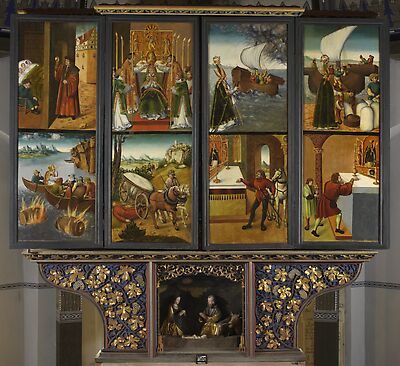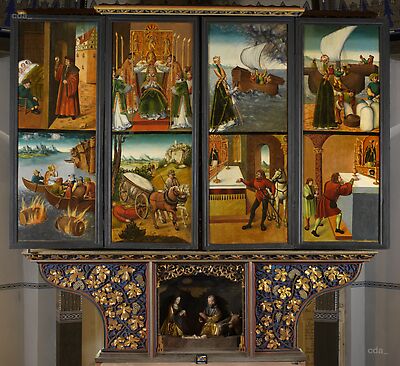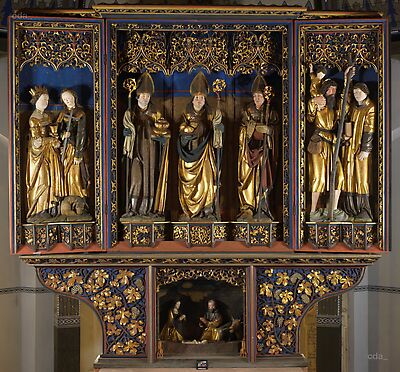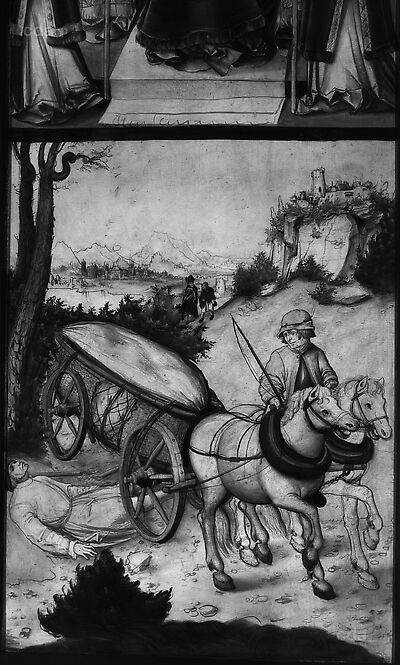The outer wing panels of the altar depict Christ's passion, while the inner wing panels (the 1st transformation) illustrate the Legend of St Nicolas. The shrine contains almost life-size wooden statues of various bishops, among them St Nicolas.
Like in Döbeln the church patron St Nicolas is the centre piece of
The outer wing panels of the altar depict Christ's passion, while the inner wing panels (the 1st transformation) illustrate the Legend of St Nicolas. The shrine contains almost life-size wooden statues of various bishops, among them St Nicolas.
Like in Döbeln the church patron St Nicolas is the centre piece of the open altar. Beside him rank Erasmus [...] and a bishop holding a book and a ciborium (?) (Donatus of Arezzo?). The wings of the shrine contain saints Barbara and Margaret on the left and on the right Christopher, the patient bearer of 'divine burden', and a saint whose attribute is now lost (Leonard?). The predella contains a relief representation of the Nativity with a painted scene of the Annunciation to the Shepherds in the background.
The St Nicolas series, which is the most complete version in Saxony, faithfully illustrates the stages of the saint's life. However some of the more popular miracles are missing.
This panel depicts:
- the second scene of the series: Nicolas is consecrated Bishop of Myra. When the bishops of the Province of Lycia were hasten to elections, the most influential among them heard a voice in a dream, stating that the first visitor to the church the following morning bearing the name Nicolas should be elected bishop. The benefactor Nicolas was the first to enter.
- from the lower register of the series: a man run over by a wagon with money pouring out of broken walking stick. This scene is less symbolic and eulogises instead the saint's miraculous powers. In the background Nicolas arrives accompanied by the Jew who had been cheated by the man now lying dead in the foreground. In court the debtor had sworn that an outstanding sum had been repaid and while he made this claim he gave the Jew the walking stick filled with money to hold. The unsuspecting Jew then returned the walking stick. As punishment the wrongdoer was run over, but was then saved by Nicolas. The Jew would only take back the money that had come to light if the Christian culprit was raised from the dead. According to the legend after this miracle the Jew converted to Christianity.
[Sandner 1993, 146-148]
![The Former Highaltar the Church of St Nicolas, Grimma: Nicolas is made bishop of Myra; The Miracle of the Man run over by a Wagon [left inner wing, 1st transformation]](https://lucascranach.org/imageserver-2022/DE_FKG_FKG001D_FR-none/01_Overall/DE_FKG_FKG001D_FR-none_2016-09_Overall-s.jpg)

![The Former Highaltar the Church of St Nicolas, Grimma: St Nicolas saves the Sailors from the Stormt; A Knight with his Horse before St Nicolas' Altarpiece [right inner wing, 1st transformation]](https://lucascranach.org/imageserver-2022/DE_FKG_FKG001E_FR-none/01_Overall/DE_FKG_FKG001E_FR-none_2016-09_Overall-s.jpg)
![The Former Highaltar the Church of St Nicolas, Grimma: St Nicolas donates gold; St Nicolas as Protector of Pilgrims [interior of outer left wing, 1st transformation]; Christ before Caiaphas; Ecce Homo [exterior of outer left wing, 2nd transformation]](https://lucascranach.org/imageserver-2022/DE_FKG_FKG001F_FR-none/01_Overall/DE_FKG_FKG001F_FR-none_2016-09_Overall-s.jpg)
![The Former Highaltar the Church of St Nicolas, Grimma: the Miracle of the Wheat; The Miracle of the Golden Chalice [interior of outer right wing, 1st transformation]; Christ before Pilate; Christ carrying the Cross [exterior of outer right wing, 2nd transformation]](https://lucascranach.org/imageserver-2022/DE_FKG_FKG001G_FR-none/01_Overall/DE_FKG_FKG001G_FR-none_2016-09_Overall-s.jpg)
![The Former Highaltar the Church of St Nicolas, Grimma: The Arrest of Christ; The Mocking of Christ, [left fixed wing, 2nd transformation]](https://lucascranach.org/imageserver-2022/DE_FKG_FKG001H_FR-none/01_Overall/DE_FKG_FKG001H_FR-none_2016-09_Overall-s.jpg)
![The Former Highaltar the Church of St Nicolas, Grimma: The Flagellation; The Crucifixion, [right fixed wing, 2nd transformation]](https://lucascranach.org/imageserver-2022/DE_FKG_FKG001I_FR-none/01_Overall/DE_FKG_FKG001I_FR-none_2016-09_Overall-s.jpg)


